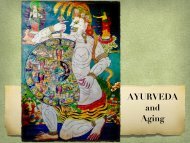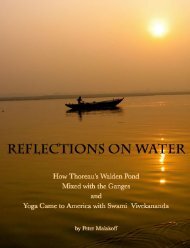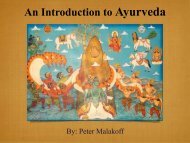How Thoreau's Walden Pond Mixed with the Ganges and Yoga Came to America with Swami Vivekananda
One early morning in 1846, during the coldest days of a New England winter, Henry David Thoreau looked out the window of his small cabin on Walden Pond and saw men cutting its ice into blocks. That ice was hauled by horse to a railroad that ran across the western edge of Walden Pond, packed into a boxcar, taken to Boston and loaded onto a clipper ship that sailed to Calcutta, India, arriving about four months later. Once there, that ice was purchased by grateful members of the East India Company. Thoreau had witnessed a small part of the global ice trade between New England and India that took place during the latter part of the nineteenth century. When Thoreau considered the ice trade, his vision sailed on metaphors far beyond the scope of business. The waters he imagined flowed both east and west and carried not just natural elements, but culture, religion and philosophy as well. He envisioned that after arriving in Calcutta, the New England ice of Walden Pond would eventually melt and run downhill where it would join with the sacred water of the Ganges. He wrote in Walden: "It appears that the sweltering inhabitants of Charleston and New Orleans, of Madras and Bombay and , drink at my well. In the morning I bathe my intellect in the stupendous and cosmogonal philosophy of the , since whose composition years of the gods have elapsed, and in comparison with which our modern world and its literature seem puny and trivial; and I doubt if that philosophy is not to be referred to a previous state of existence, so remote is its sublimity from our conceptions. I lay down the book [Bhagavad-Gita] and go to my well for water, and lo! there I meet the servant of the Bramin, priest of and and who still sits in his temple on the Ganges reading the , or dwells at the root of a tree with his crust and water jug. I meet his servant come to draw water for his master, and our buckets as it were grate together in the same well. The pure Walden water is mingled with the sacred water of the Ganges." This book tells the story of these waters . . .
One early morning in 1846, during the coldest days of a New England winter, Henry David Thoreau looked out the window of his small cabin on Walden Pond and saw men cutting its ice into blocks. That ice was hauled by horse to a railroad that ran across the western edge of Walden Pond, packed into a boxcar, taken to Boston and loaded onto a clipper ship that sailed to Calcutta, India, arriving about four months later. Once there, that ice was purchased by grateful members of the East India Company. Thoreau had witnessed a small part of the global ice trade between New England and India that took place during the latter part of the nineteenth century.
When Thoreau considered the ice trade, his vision sailed on metaphors far beyond the scope of business. The waters he imagined flowed both east and west and carried not just natural elements, but culture, religion and philosophy as well. He envisioned that after arriving in Calcutta, the New England ice of Walden Pond would eventually melt and run downhill where it would join with the sacred water of the Ganges. He wrote in Walden: "It appears that the sweltering inhabitants of Charleston and New Orleans, of Madras and Bombay and , drink at my well. In the morning I bathe my intellect in the stupendous and cosmogonal philosophy of the , since whose composition years of the gods have elapsed, and in comparison with which our modern world and its literature seem puny and trivial; and I doubt if that philosophy is not to be referred to a previous state of existence, so remote is its sublimity from our conceptions.
I lay down the book [Bhagavad-Gita] and go to my well for water, and lo! there I meet the servant of the Bramin, priest of and and who still sits in his temple on the Ganges reading the , or dwells at the root of a tree with his crust and water jug. I meet his servant come to draw water for his master, and our buckets as it were grate together in the same well. The pure Walden water is mingled with the sacred water of the Ganges."
This book tells the story of these waters . . .
Create successful ePaper yourself
Turn your PDF publications into a flip-book with our unique Google optimized e-Paper software.
Vedanta<br />
Vedanta is one of <strong>the</strong> six systems of Indian Philosophy. The word, Vedanta,<br />
means <strong>the</strong> anta or end of <strong>the</strong> Veda or knowledge.<br />
“Vedanta was originally a word used in Hindu philosophy as a synonym for that<br />
part of <strong>the</strong> Veda texts also known as <strong>the</strong> Upanishads.<br />
It is speculated that "Vedānta" means "<strong>the</strong> purpose or goal [end] of <strong>the</strong> Vedas.”<br />
Vedanta can also be used as a noun <strong>to</strong> describe one who has mastered all<br />
four of <strong>the</strong> original Vedas.<br />
By <strong>the</strong> 8th century, <strong>the</strong> word came <strong>to</strong> be used <strong>to</strong> describe a group of philosophical<br />
traditions concerned <strong>with</strong> <strong>the</strong> self-realisation by which one underst<strong>and</strong>s<br />
<strong>the</strong> ultimate nature of Reality (Brahman).<br />
In this respect Vedānta is also called Uttarā Mīmāṃsā, or <strong>the</strong> 'latter enquiry'<br />
or 'higher enquiry', <strong>and</strong> is often paired <strong>with</strong> Purva Mīmāṃsā, <strong>the</strong> 'former enquiry'.<br />
Pūrva Mimamsa, usually simply called Mimamsa, deals <strong>with</strong> explanations<br />
of <strong>the</strong> fire-sacrifices of <strong>the</strong> Vedic mantras (in <strong>the</strong> Samhita portion of <strong>the</strong> Vedas)<br />
<strong>and</strong> Brahmanas, while Vedanta explicates <strong>the</strong> esoteric teachings of <strong>the</strong><br />
Āraṇyakas (<strong>the</strong> "forest scriptures"), <strong>and</strong> <strong>the</strong> Upanishads, composed from <strong>the</strong> 9th<br />
century BCE until modern times.<br />
Vedanta is not restricted or confined <strong>to</strong> one book <strong>and</strong> <strong>the</strong>re is no sole source<br />
for Vedāntic philosophy.<br />
The primary philosophy captured in <strong>the</strong> Upanishads, that of one absolute<br />
Reality termed as Brahman is <strong>the</strong> main principle of Vedanta. The sage Vyāsa<br />
was one of <strong>the</strong> major proponents of this philosophy <strong>and</strong> author of <strong>the</strong> Brahma<br />
Sūtras based on <strong>the</strong> Upanishads. The concept of Brahman – <strong>the</strong> eternal, selfexistent,<br />
immanent <strong>and</strong> transcendent Supreme <strong>and</strong> Ultimate Reality which is<br />
<strong>the</strong> divine ground of all Being - is central <strong>to</strong> most schools of Vedānta. The concept<br />
of God or Ishvara is also <strong>the</strong>re, <strong>and</strong> <strong>the</strong> Vedantic sub-schools differ mainly<br />
in how <strong>the</strong>y identify God <strong>with</strong> Brahman.”<br />
– Wikipedia, The Free Encyclopedia<br />
Related Glossary Terms<br />
Advaita, Advaita Vedanta, Advaitic, Advaitin, Rig Veda, Vedas<br />
Index<br />
Find Term<br />
Section 6 - Introduction<br />
Section 6 - Introduction<br />
Section 6 - Introduction<br />
Chapter 1 - <strong>How</strong> <strong>Thoreau's</strong> <strong>Walden</strong> <strong>Pond</strong> <strong>Mixed</strong> <strong>with</strong> <strong>the</strong> <strong>Ganges</strong> <strong>and</strong> <strong>Yoga</strong> <strong>Came</strong> <strong>to</strong> <strong>America</strong> <strong>with</strong> <strong>Swami</strong> Vivekan<strong>and</strong>a<br />
Chapter 1 - <strong>How</strong> <strong>Thoreau's</strong> <strong>Walden</strong> <strong>Pond</strong> <strong>Mixed</strong> <strong>with</strong> <strong>the</strong> <strong>Ganges</strong> <strong>and</strong> <strong>Yoga</strong> <strong>Came</strong> <strong>to</strong> <strong>America</strong> <strong>with</strong> <strong>Swami</strong> Vivekan<strong>and</strong>a


















